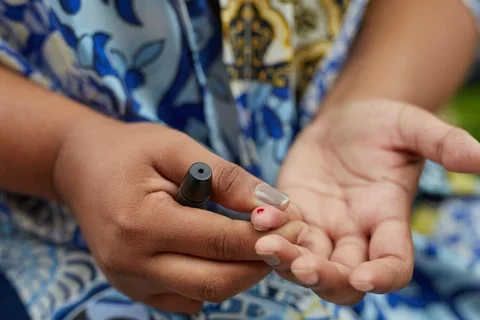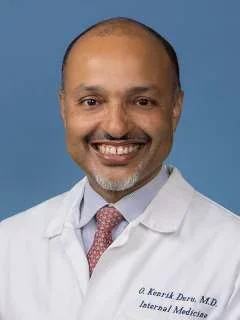Can Diabetes Be Reversed?
Research Spotlight

What Is Diabetes?
UCLA internist and diabetes expert Obidiugwu (Kenrik) Duru, MD, MS, says diabetes can be defined by its end state: high blood sugars. There are different types of diabetes caused by different factors but they all result in high blood sugars.
Blood sugars become elevated when something disrupts the optimal function of insulin, the glucose-regulating hormone produced in the pancreas. Ideally, the pancreas produces and secretes just enough insulin—not too little and not too much—to help carbohydrates in the bloodstream enter cells and be used as energy.
When this process goes wrong for any reason, glucose builds up in the bloodstream and blood vessels, leading to the health complications associated with diabetes, such as vision loss and kidney disease.
Meet Dr. Obidiugwu (Kenrik) Duru
Dr. Duru realized he wanted to be a doctor early in life and pursued that goal at an accelerated rate. He got accepted into both college and medical school when he was just a senior in high school.
After studying internal medicine at the University of California San Francisco (UCSF) School of Medicine, he began practicing primary care and also conducting research on diabetes. A family history of diabetes, and a thirst to make a difference, motivated him to pursue his research.

“I felt there had to be a way to get people to make lifestyle changes, eat smaller portions, and be more active to get their diabetes controlled,” he says. “That seemed tangible and doable, and I could see myself helping make that happen.”
He encourages lifestyle changes by thinking from a broader perspective—stepping out of the doctor’s office and truly thinking about a patient’s day-to-day life. He learned to value this approach while earning his master’s degree in health services. Systemic factors influence patient behavior outside the clinic, but considering and addressing those factors at the clinic can improve patient outcomes.
What Is Type 1 Diabetes?
Type 1 diabetes results from an insulin deficit.
In type 1 diabetes, the pancreas doesn’t make enough insulin to help glucose in the bloodstream enter cells and become energy. People with this type of diabetes need to get insulin from an outside source.
What Is Type 2 Diabetes?
Type 2 diabetes results from insulin resistance.
“Type 2 diabetes is often driven by excess weight that leads to insulin resistance,” Dr. Duru explains. “That’s especially true for excess weight that develops around the stomach—something called visceral fat.”
Normally, cells react to insulin by opening up and letting carbohydrates in. In insulin resistance, the normal amount of insulin fails to open cells. Instead of entering cells to be used as energy, the carbohydrates build up in the blood.
“When cells are resistant, it takes more and more insulin to get them to open, and then at some point, the insulin stops working on the cells at all,” Dr. Duru says. “It would be like really revving up the revolutions per minute (RPMs) in your car just to get it to move, wearing down the engine in the process.”
Dr. Duru advises patients who’ve been diagnosed with type 1 or type 2 diabetes to ask their primary care doctor if they might benefit from additional screening to rule out less common types of diabetes.
“The treatments often differ,” he explains. “There are a lot of patients out there who just assume they have type 2 diabetes, because that accounts for about 95% of diabetes cases. In reality, it may be something that should be treated differently.”
What Is Prediabetes?
Diabetes exists on a continuum. Dr. Duru says people can think of diabetes as controlled by a slider instead of an on-off switch.
“We have set a point along the slider that is diabetes,” he says. “And prediabetes happens when you’re sliding away from the starting point and closer to the point marking diabetes, often because of suboptimal eating or exercise habits. It’s a warning sign.”
However, the slider can move both ways.
Just as negative behaviors can move the slider toward diabetes, positive lifestyle changes can move it away from diabetes and toward normal glycemic regulation.
What Is Gestational Diabetes?
Gestational diabetes refers to elevated blood sugar that occurs during pregnancy. It results from insulin resistance that develops due to the natural weight gain and hormonal changes associated with pregnancy.
Mothers who had gestational diabetes are at a high risk of developing diabetes after pregnancy, even if their blood sugars return to normal levels.
“It's like a check engine light,” Dr. Duru says. “In a healthy pregnancy, you naturally gain a fair amount of weight. However, your fat works the same as it would if you gained weight any other way, so you end up moving toward insulin resistance.”
OBGYNs monitor gestational diabetes closely during pregnancy, as it can lead to birth complications. Often, mothers lose their baby weight after delivery, their blood sugars go back to normal, and they consider their gestational diabetes an issue they had during pregnancy, not something to worry about moving forward.
“But gestational diabetes is a sign that something’s not right,” Dr. Duru says. “Mothers who experience gestational diabetes still have a risk of developing diabetes after delivery, and their gestational diabetes often recurs if and when they become pregnant again.”
Help Shape the Future of Diabetes Care by Joining the UCLA Diabetes Research Registry
What Causes Diabetes?
What causes type 1 diabetes?
Type 1 diabetes is likely caused by an autoimmune attack.
Researchers are still learning about what causes type 1 diabetes, but they believe it happens when someone’s immune system attacks a virus and accidentally attacks the pancreas as well, destroying insulin-producing cells.
Researchers at UCLA and beyond are investigating medications that could potentially slow down immune reactions and preserve pancreatic function.
What causes type 2 diabetes?
Type 2 diabetes is caused by insulin resistance, which usually stems from a combination of factors.
Dr. Duru says most of the type 2 diabetes cases he sees can be linked primarily to weight gain associated with unhealthy diets, a lack of exercise, and/or a genetic predisposition to insulin resistance.
Is diabetes genetic?
Dr. Duru says that type 2 diabetes runs in families and that genetic factors contribute to its development.
“However, genes are not your destiny,” he says. “Even if you have diabetes in your family, particularly type 2 diabetes, you can still take steps to avoid going down the same path.”
Can you get diabetes from eating too much sugar?
Eating too much of any unhealthy foods in general can lead to diabetes.
“Eating too much sugar is one factor,” Dr. Duru explains. “But ultimately, your diet as a whole, influences the development of diabetes.”
Foods that generally increase the risk of developing diabetes, especially when over-consumed, include:
- Sugar
- Fried foods
- Fatty foods
- Simple carbohydrates
- Processed foods
Food that do not increase the risk of developing diabetes include:
- Vegetables
- Fruits
- Lean meats
- Fiber-rich foods

How to Prevent Diabetes
Are there ways to prevent or avoid diabetes?
There are ways to prevent diabetes, and they all revolve around maintaining a healthy daily lifestyle involving smart dietary choices and a regular exercise routine.
Dr. Duru believes diabetes has become more prevalent because people, in general, don’t eat as well as they did a few decades ago. Many people have leaned away from cooking meals at home using fresh ingredients and toward fast and frozen convenience foods that better fit their busy lifestyles.
Simply cultivating more awareness around food choices can help people take steps toward a healthier lifestyle.
“I tell my patients to be really thoughtful,” Dr. Duru says. “I can’t tell them not to eat sweets at all because that’s just not realistic. I can tell them to be conscious of everything they eat.”
He’s found this simple rule resonates with people and helps them make progress and find a healthy balance. For example, a person might make the conscious choice to eat something less-than-healthy today, such as a sugary dessert, with the intention to balance out that indulgence by avoiding desserts for the next few days.
Why are certain ethnic or socioeconomic groups more likely to develop diabetes?
The elevated diabetes risks observed in some socioeconomic groups are likely tied to lifestyle.
“Unhealthy food is cheaper,” Dr. Duru says. “And even though we’ve tried to make healthy food less expensive, unhealthy food is still more affordable and more widely available.”
Time and stress also factor into diabetes risk. In addition to being inexpensive, many unhealthy foods are also fast and easy to get. Busy people dealing with stress and financial strain will naturally gravitate toward food options that are fast, convenient, and inexpensive.
The fact that it requires time to be physically active creates compounding issues: unhealthy diets paired with a lack of exercise.
“If you’re working long hours and you need to take two buses to get to your job, and your job doesn’t have the flexibility to take workout breaks, then it’s hard to find time for exercise.”
Dr. Duru says cases of diabetes linked to certain races or ethnicities may revolve around the cultural aspects of food.
Food, sometimes less-than-healthy food, may be deeply ingrained in the identity shared by cultures or individual families. Health-driven modifications to meals or recipes may be tried but not adopted in the long run.
Through eating habits and recipes passed down from generation to generation, diabetes can run in families without having an underlying genetic cause.
How to Know If You Have Diabetes
What Are the Symptoms of Diabetes?
Type 1 diabetes symptoms
Type 1 diabetes typically comes with noticeable symptoms, including confusion, rapid and unexplained weight loss, fatigue, weakness, and persistent infection. These symptoms usually develop in just a few weeks.
Dr. Duru says most people who experience these symptoms or observe them in their children know immediately that something is wrong and go to the hospital, where a diagnosis can be made.
Type 1 diabetes is sometimes called “adolescent diabetes” or “juvenile diabetes” because it often presents during childhood.
Type 2 diabetes symptoms
Unlike type 1 diabetes symptoms, which develop in weeks, type 2 diabetes symptoms may develop over multiple months and even years.
The 3 classic symptoms of type 2 diabetes include:
- Blurry vision
- Frequent urination
- Weight loss
Blurry vision happens because there are sugar molecules in the eyes. Frequent urination is the body’s attempt to evacuate excess sugar and also leads to weight loss because it interferes with caloric absorption.
Does Diabetes Make You Tired?
Dr. Duru’s type 2 diabetes patients report drowsiness immediately after eating.
“Often that’s a sign your sugar is going way up and your body is shutting down,” he says, explaining this can happen to everyone occasionally but that people who notice it happening frequently could benefit from a diabetes screening.
How Is Diabetes Diagnosed?
Physicians most often diagnose diabetes with a quick and easy blood test on hemoglobin A1C, a protein found in blood cells. Unlike other blood tests, a hemoglobin A1C test doesn’t require fasting to return accurate results.
“Glucose is sticky sugar. It tends to stick to everything, including blood cells,” Dr. Duru says.
Just looking at a person’s blood cells can help a physician assess their blood sugar levels.

Can Diabetes Be Cured?
Can You Get Rid of Diabetes?
There’s no cure for diabetes and no way to completely get rid of it. However, diabetes can be reversed in most people.
Reversing diabetes means carefully managing blood sugars to a point where medications are no longer necessary, and staying at that manageable point through a healthy routine of diet and exercise.
Returning to Dr. Duru’s slider analogy clarifies what it means to reverse diabetes. Healthy habits move the slider toward a more manageable state; they cannot switch the diabetes “off.” Furthermore, the slider can move back toward diabetes if someone fails to maintain healthy habits.
How to Reverse Diabetes
In general, addressing the underlying weight issues that led to diabetes can help reverse it.
A focus on eating less separates reversing diabetes from managing diabetes, which doesn’t necessarily involve weight loss. Managing diabetes involves stabilizing blood sugar levels through lifestyle modifications and medications such as Metformin.
“Just as diabetes can be defined as high blood sugars no matter what makes them high, reversing diabetes can be accomplished by eating less via any method, whether it’s personal resolution, medication, or surgery.”
Dr. Duru noted two different approaches to eating less that work to reverse diabetes in most, but not all, people: bariatric surgery and weight loss drugs.
Bariatric surgery
People with diabetes who have a body mass index of 35 or higher may qualify for bariatric surgery, a procedure that alters the stomach to induce weight loss. It can reverse diabetes in about 60-70% of qualifying individuals and involves a long pre-surgical process, including a psychological evaluation.
One frequently performed type of bariatric surgery—gastric sleeve surgery (gastrectomy)—reduces the stomach’s capacity for food and naturally causes people to eat smaller portions.
Weight loss drugs
Weight loss drugs with the potential to reverse diabetes include GLP-1 agonists, such as Ozempic and Trulicity.
When people eat, their bodies generate a hormone called GLP-1, which reduces feelings of hunger. However, Dr. Duru explains that it goes away quickly, causing people to feel hungry again. GLP-1 agonists work in the brain to stop feelings of hunger for up to a week.
Are there specific diets and/or foods that are good for people with diabetes?
Fruits, vegetables, fish, lean meats, and Mediterranean diets are healthy for all people, including those with diabetes.
Dr. Duru advises people to eat foods that come out of the earth as they came out of the earth. That includes eating whole apples with skins intact instead of drinking apple juice and choosing brown rice instead of bleached white rice. He adds that eating fiber-rich foods is also a smart strategy because fiber fills up the stomach and keeps it full.
“We believe fiber actually feeds the bacteria, the microbiome, in the intestines. When the microbiome is satisfied with the nutrition it has, it doesn’t keep sending signals to eat, which could otherwise contribute to weight gain.”
Can people with diabetes drink alcohol?
People with diabetes can drink alcohol but should do so within evidence-based limits, such as those established by the U.S. Department of Agriculture and U.S. Department of Health and Human Services in their Dietary Guidelines for Americans. (2 or fewer drinks a day for men and 1 or fewer drinks a day for women.)
“I think the key is also to have drinks with limited carbohydrates,” Dr. Duru says. “That means choosing light beer or dry wine over mixed drinks with high sugar content.”
What kind of exercise is best for people with diabetes?
Dr. Duru urges people to remember that the most important thing is incorporating any exercise in your regular routine. Ideally, that exercise will include a combination of aerobic activity and strength training to maximize weight loss and also reduce insulin resistance.
“A lot of the glucose going into cells goes into muscles,” he explains. “Muscles that are active and working can take in glucose more easily, and that helps lower your blood sugar. Active muscles are also less prone to insulin resistance.”
While diet is important for managing and reversing diabetes, focusing on diet alone can result in intermittent progress followed by setbacks. Exercise complements diet to achieve sustainable, long-term lifestyle changes.
How is stress related to diabetes?
Dr. Duru says stress may be linked to diabetes simply because it leads to other unhealthy behaviors, such as stress eating and getting inadequate sleep and exercise.
Stress might activate the hormone epinephrine (adrenaline)—the fight or flight hormone—which can also raise blood sugar levels.
“This makes biological sense. If you’re faced with a bear, you want blood sugar in your muscles so you can run fast.”
However, most people experience a chronic variety of stress. They don’t need a blood sugar spike to evade danger. Their biggest threat is perpetually elevated blood sugar levels.
Diabetes Awareness Month
For Diabetes Awareness Month, honored every November, Dr. Duru wants to dispel one big misconception about diabetes he’s encountered over the years.
Misconception: Insulin worsens the complications of diabetes.
“A lot of people think insulin worsens the complications of diabetes, when in fact, insulin is treating them.”
People who need insulin often experience the most diabetes-related complications.
“As a result, a lot of patients think it's the insulin that led to those things, but that’s not the case. If you need insulin, it will help you. It will not make diabetes complications progress.”
Dr. Duru also wants people to know—whether they have a high risk of developing diabetes or have already been diagnosed—that they can change their destiny through lifestyle adjustments, medications, or both.
He urges people who’ve been diagnosed with diabetes not to feel guilty.
“It's not a life failing to have diabetes,” he says. “It’s not like you did anything wrong. Part of it is genetics and part of it is living in a Western society. It’s not your fault that you’re programmed to get all the calories you can and that you currently live in a calorically abundant society.”



